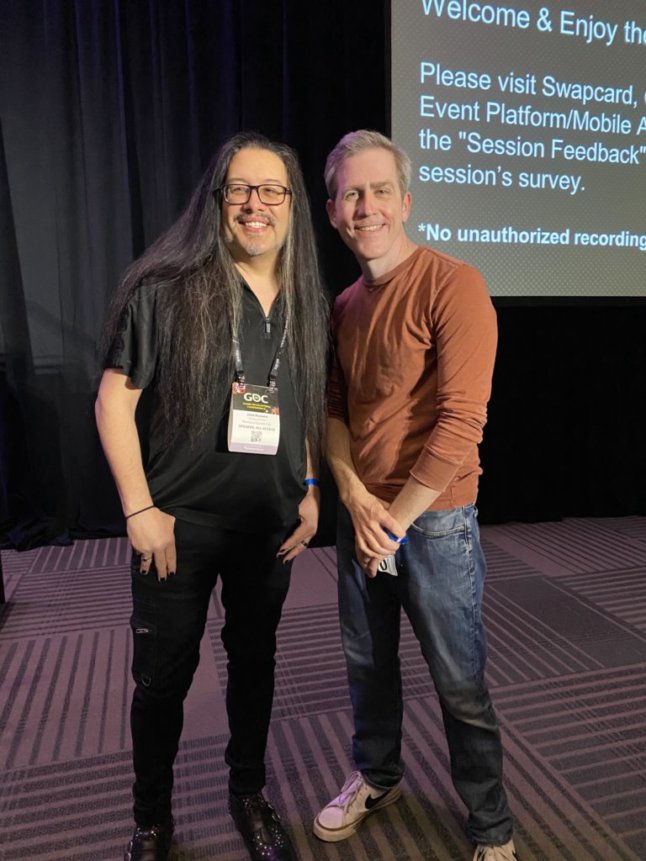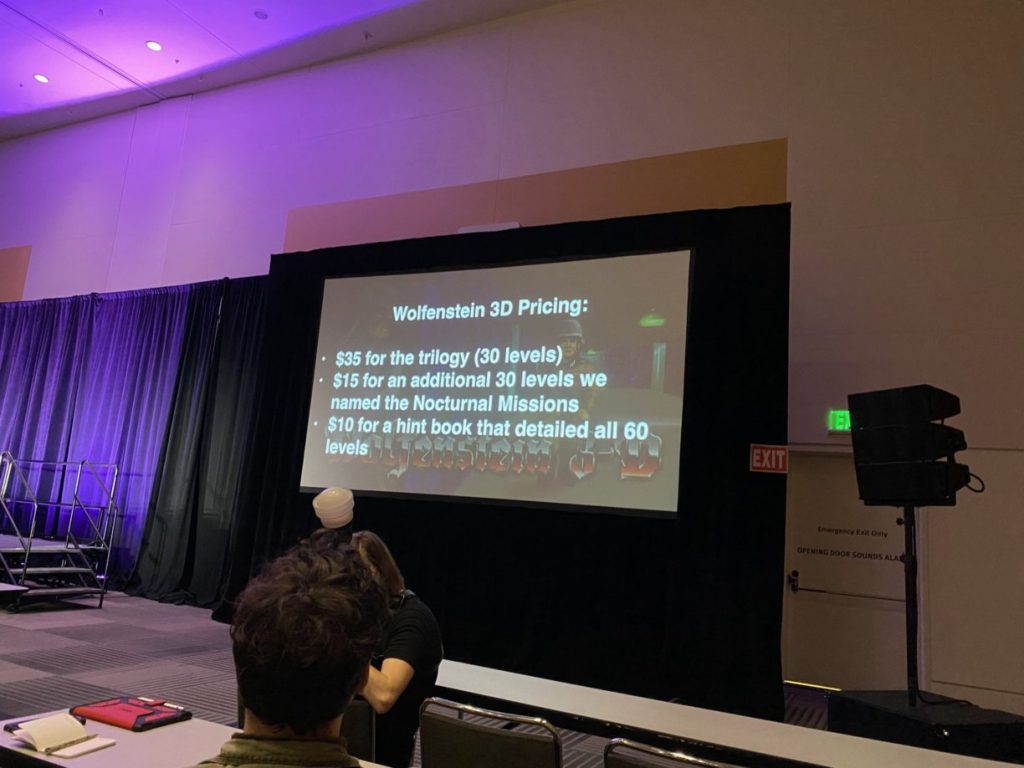
Designer / Developer John Romero walks us through In this retrospective of the classic PC game Wolfenstein 3D
CZ Side note Wolfenstein 3D was the very first PC Shareware game that I bought. It is also the first FPS I ever played. One night My dad brought home a generic 3.25 inch floppy disk with the words “Wolf 3D” on it and he said “One of my coworkers said you would like this.” I wat over-imagined what wolf 3d would be but I was completely blown away by what it actually was. By attending this talk I actually got to meet and shake designer John Romero’s hand. This is one of the reasons it is so fun to go to GDC. Going to GDC you get to learn cool things like you are the exact height of John Romero.
This talk was primarily a chronological narrative leading up to the release of Wolfenstein 3D. There are a couple marketing things that I call out here.
1991
- Delivered commander keen 4 and 5 and Catacomb 3-D. You must release a TON of games.
- SoundBlaster was just coming in to most PCs
- 386 Processors were big
- ID was in Madison, Wisconsin
1992
- The iD team started work on Commander Keen 7 but decided to make a 3d game because they were tired of it
- CZ NOTE: They release lots of games. They learned how games worked.
- They decided to make a better 3d game
- Decided to do a 1981 remake of Castle Wolfenstein
- Apogee was their publisher and the publisher was really excited to do that for a project
- Decided each episode would have 10 levels
- John Carmack got the renderer working in a week
- The shareware had 4 enemies
- Original 1981 Wolfenstein game was a stealth sneaking and looting bodies game.
- But after making it in 3D they realized running and gunning was more fun than dragging enemies around. So they made it a run and gun game.
Feb 1992
- Kings quest V came out and mailed commander keen to Roberta Williams because they were making some educational games
- Then Romero was invited to visit the Williams couple in their home.
- CZ Side note: Book recommendation: Hackers: Heroes of the Computer Revolution
- While visiting, Romero showed Ken Williams Wolf 3D but Ken was not impressed. Ken thought flight sim was better and the future of games.
- Ken was unimpressed with looked at their books and saw they were making $50,000 a month in Shareware.
- Ken offered them $2,000,000 in Sierra shock if they sold to sell ID to them. Romero countered with $100k in money up front. Ken turned it down.
- CZ NOTE: This is good biz dev hustling. You need to reach out to your peers to see if there is any benefit to working together. Do it
March 1992
- “Be the wind” was their motto
- The entire team wanted secret push walls but Carmack didn’t want to add them because it violated the sanctity of his code.
Trade mark
- Muse software – The original publisher of Wolfenstein 2D
- Some woman bought a bunch of assets from businesses that went under. So she had it and they bought the IP from her for $5,000.
- CZ Note: More good hustling getting the IP
June 1992
- They were working on when shareware version would come out. Someone on the team suggested they start taking orders after the shareware ships but before they finish production of the full game. Risky.
Merchandicing:
- They offered an up sell. You could buy the full game or get an additional 30 levels and a hint book for a higher price.
- CZ Note: This is smart! Merchandise your stuff

May 1992
- Days away from finishing, the game didn’t fit on 1 disk.
- Romero wrote the installer for 2 years. He gave it to apogee and they used it for all their games.
- Software creations BBS was where they uploaded the shareware first. Upload time was 4am.
- Added the fastest run times in the hint manual – speed running games were invented here.
June 15, 1992 – Shareware design:
- Scott Miller was the one who came up with the pricing scheme for the full version
- The shareware cutoff of 10 levels and a boss was just based on experience of what the best way to design the share ware
- CZ Side note: the game also ended after you beat the boss by the player running outside. I thought that was so cool and also wanted to see what it would be like to play a FPS that was outside. So great cliff hanger.
Other random development tips
- How did you test? We just played a lot
- Fix your bugs immediately after finding them. otherwise you are building on top of bad code.
- Test your code after just a bit of coding – essentially work 30 min – then test extensively